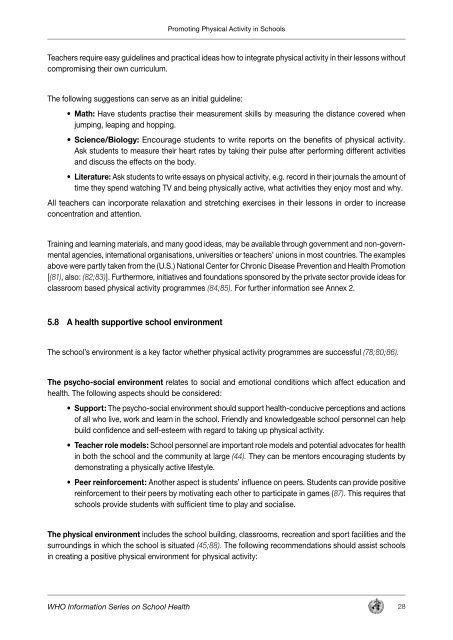WHO INFORMATION SERIES ON SCHOOL HEALTH ... - PAHO/WHO
WHO INFORMATION SERIES ON SCHOOL HEALTH ... - PAHO/WHO
WHO INFORMATION SERIES ON SCHOOL HEALTH ... - PAHO/WHO
Create successful ePaper yourself
Turn your PDF publications into a flip-book with our unique Google optimized e-Paper software.
Promoting Physical Activity in Schools<br />
Teachers require easy guidelines and practical ideas how to integrate physical activity in their lessons without<br />
compromising their own curriculum.<br />
The following suggestions can serve as an initial guideline:<br />
• Math: Have students practise their measurement skills by measuring the distance covered when<br />
jumping, leaping and hopping.<br />
• Science/Biology: Encourage students to write reports on the benefits of physical activity.<br />
Ask students to measure their heart rates by taking their pulse after performing different activities<br />
and discuss the effects on the body.<br />
• Literature: Ask students to write essays on physical activity, e.g. record in their journals the amount of<br />
time they spend watching TV and being physically active, what activities they enjoy most and why.<br />
All teachers can incorporate relaxation and stretching exercises in their lessons in order to increase<br />
concentration and attention.<br />
Training and learning materials, and many good ideas, may be available through government and non-governmental<br />
agencies, international organisations, universities or teachers’ unions in most countries. The examples<br />
above were partly taken from the (U.S.) National Center for Chronic Disease Prevention and Health Promotion<br />
[(81), also: (82;83)]. Furthermore, initiatives and foundations sponsored by the private sector provide ideas for<br />
classroom based physical activity programmes (84;85). For further information see Annex 2.<br />
5.8 A health supportive school environment<br />
The school’s environment is a key factor whether physical activity programmes are successful (78;80;86).<br />
The psycho-social environment relates to social and emotional conditions which affect education and<br />
health. The following aspects should be considered:<br />
• Support: The psycho-social environment should support health-conducive perceptions and actions<br />
of all who live, work and learn in the school. Friendly and knowledgeable school personnel can help<br />
build confidence and self-esteem with regard to taking up physical activity.<br />
• Teacher role models: School personnel are important role models and potential advocates for health<br />
in both the school and the community at large (44). They can be mentors encouraging students by<br />
demonstrating a physically active lifestyle.<br />
• Peer reinforcement: Another aspect is students’ influence on peers. Students can provide positive<br />
reinforcement to their peers by motivating each other to participate in games (87). This requires that<br />
schools provide students with sufficient time to play and socialise.<br />
The physical environment includes the school building, classrooms, recreation and sport facilities and the<br />
surroundings in which the school is situated (45;88). The following recommendations should assist schools<br />
in creating a positive physical environment for physical activity:<br />
<strong>WHO</strong> Information Series on School Health 28

















